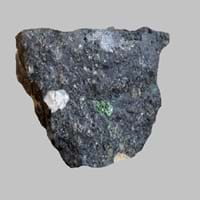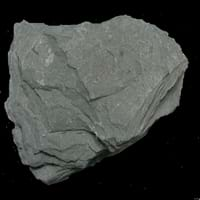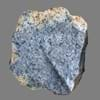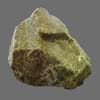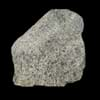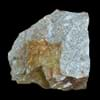Definition
Kimberlite is a rare, blue-tinged, coarse-grained intrusive igneous rock, which sometimes contains diamonds and is mostly found in South Africa and Siberia.
Slate is a fine-grained, foliated, homogeneous metamorphic rock derived from an original shale-type sedimentary rock composed of clay or volcanic ash through low-grade regional metamorphism
Origin
Kimberley, South Africa
England
Discoverer
Unknown
Unknown
Etymology
From Kimberley + -ite, from the name of the South African town of Kimberley where the rock was first found.
From Old French esclate, from esclat (French éclat)
Class
Igneous Rocks
Metamorphic Rocks
Sub-Class
Durable Rock, Hard Rock
Durable Rock, Medium Hardness Rock
Group
Volcanic
Not Applicable
Other Categories
Coarse Grained Rock, Fine Grained Rock, Opaque Rock
Fine Grained Rock, Opaque Rock
Texture
Porphyritic
Foliated
Color
Black, Bluish - Grey, Brown, Dark Greenish - Grey, Green, Grey
Black, Brown, Buff, Green, Light to Dark Grey, Purple, Red, Shades of Blue
Durability
Durable
Durable
Scratch Resistant
Yes
Yes
Appearance
Dull and Banded
Dull
Interior Uses
Countertops, Decorative Aggregates, Homes, Interior Decoration
Bathrooms, Decorative Aggregates, Entryways, Floor Tiles, Flooring, Homes, Hotels, Interior Decoration, Kitchens, Stair Treads
Exterior Uses
As Building Stone, Paving Stone, Garden Decoration
As Building Stone, As Facing Stone, Garden Decoration, Paving Stone
Other Architectural Uses
Curbing
Curbing
Construction Industry
As a Flux in the Production of Steel and Pig Iron, As a Sintering Agent in Steel Industry to process Iron Ore, As Dimension Stone, Cement Manufacture, for Road Aggregate, Making natural cement, Manufacture of Magnesium and Dolomite Refractories
As Dimension Stone
Medical Industry
Taken as a Supplement for Calcium or Magnesium
Not Yet Used
Antiquity Uses
Artifacts, Monuments, Sculpture, Small Figurines
Artifacts, Monuments, Sculpture, Small Figurines
Commercial Uses
An Oil and Gas Reservoir, As a Feed Additive for Livestock, Gemstone, Metallurgical Flux, Production of Lime, Soil Conditioner, Source of Magnesia (MgO)
Blackboards, Commemorative Tablets, Laboratory bench tops, Standard material for the bed of Billiard table, Standard material for the beds of Pool and Snooker table, Tombstones, Used in aquariums, Writing Slates
Types
Basaltic Kimberlites and Micaceous Kimberlites
Not Available
Features
Always found as volcanic pipes over deep continental crust, Host rock for Diamond, Is one of the oldest rock, Surfaces are often shiny
Easily splits into thin plates, Surfaces are often shiny, Very fine grained rock
Archaeological Significance
Famous Monuments
Data Not Available
Data Not Available
Famous Sculptures
Data Not Available
Data Not Available
Pictographs
Not Used
Used
Petroglyphs
Not Used
Used
Formation
Kimberlite is an igneous rock and is the main source of diamonds. Its formation takes place deep beneath the Earth’s surface between 150 to 450 kilometres, and are erupted rapidly and violently.
Slate is a low grade metamorphic rock that is generally formed by metamorphosis of mudstone or shale, under relatively low pressure and temperature conditions.
Mineral Content
Garnet, Olivine, Phlogopite, Pyroxene
Apatite, Biotite, Chlorite, Feldspar, Graphite, Hematite, Kaolinite, Magnetite, Pyrite, Tourmaline, Zircon
Compound Content
Aluminium Oxide, NaCl, CaO, Iron(III) Oxide, FeO, Potassium Oxide, MgO, MnO, Sodium Oxide, Silicon Dioxide, Titanium Dioxide
Aluminium Oxide, CaO, Iron(III) Oxide, Potassium Oxide, MgO, Sodium Oxide, Silicon Dioxide, Titanium Dioxide
Types of Metamorphism
Burial Metamorphism, Cataclastic Metamorphism, Contact Metamorphism, Hydrothermal Metamorphism, Impact Metamorphism, Regional Metamorphism
Burial Metamorphism, Cataclastic Metamorphism, Regional Metamorphism
Types of Weathering
Biological Weathering, Chemical Weathering, Mechanical Weathering
Biological Weathering, Chemical Weathering, Mechanical Weathering
Types of Erosion
Chemical Erosion, Coastal Erosion, Glacier Erosion, Sea Erosion, Water Erosion, Wind Erosion
Coastal Erosion, Glacier Erosion, Water Erosion, Wind Erosion
Grain Size
Fine to Coarse Grained
Very fine-grained
Fracture
Conchoidal
Splintery
Streak
White
Light to dark brown
Porosity
Very Less Porous
Less Porous
Luster
Subvitreous to Dull
Dull
Compressive Strength
Not Available
Cleavage
Conchoidal
Slaty
Toughness
Not Available
1.2
Specific Gravity
2.86-2.87
2.65-2.8
Transparency
Translucent to Opaque
Opaque
Density
2.95-2.96 g/cm3
2.6-2.8 g/cm3
Resistance
Heat Resistant, Impact Resistant
Heat Resistant, Impact Resistant, Pressure Resistant, Wear Resistant
Deposits in Eastern Continents
Asia
Russia
China, India, Turkey
Africa
Angola, Botswana, Cameroon, Ethiopia, South Africa
Not Yet Found
Europe
England, Hungary, Iceland, United Kingdom
Belgium, France, Germany, Italy, Norway, Portugal, Spain, United Kingdom
Deposits in Western Continents
North America
Canada, USA
USA
South America
Argentina, Colombia, Ecuador
Brazil
Deposits in Oceania Continent
Australia
New South Wales, New Zealand, South Australia, Western Australia
Not Yet Found
All about Kimberlite and Slate Properties
Know all about Kimberlite and Slate properties here. All properties of rocks are important as they define the type of rock and its application. Kimberlite belongs to Igneous Rocks while Slate belongs to Metamorphic Rocks.Texture of Kimberlite is Porphyritic whereas that of Slate is Foliated. Kimberlite appears Dull and Banded and Slate appears Dull. The luster of Kimberlite is subvitreous to dull while that of Slate is dull. Kimberlite is available in black, bluish - grey, brown, dark greenish - grey, green, grey colors whereas Slate is available in black, brown, buff, green, light to dark grey, purple, red, shades of blue colors. The commercial uses of Kimberlite are an oil and gas reservoir, as a feed additive for livestock, gemstone, metallurgical flux, production of lime, soil conditioner, source of magnesia (mgo) and that of Slate are blackboards, commemorative tablets, laboratory bench tops, standard material for the bed of billiard table, standard material for the beds of pool and snooker table, tombstones, used in aquariums, writing slates.
